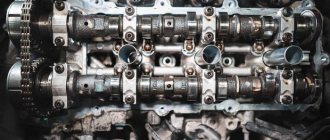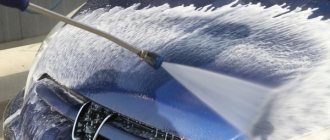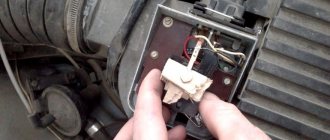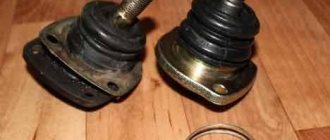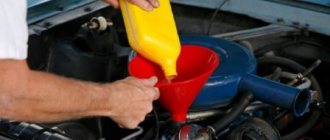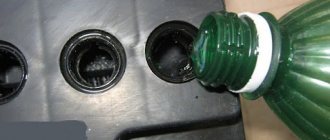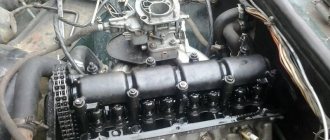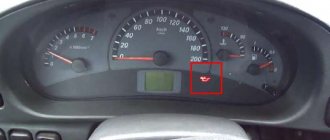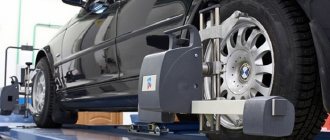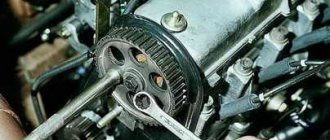The engine is a very complex mechanism; it is not without reason that it is called the heart of the car. During operation, the engine is subjected to serious thermal and mechanical loads, which are not always uniform. Deviations in engine operation require urgent attention, especially when one of the alarming symptoms appears - knocking.
Typically, knocking occurs when one part hits another, and a high load inevitably occurs at the places where they meet. Underneath it, the contacting surfaces of the parts gradually undergo destruction.
The degree of destruction is directly dependent on the force of the impacts, and if nothing is done, the gap between the parts will increase, therefore, the wear of the parts will only progress over time.
The rate of wear of parts during severe knocking depends on a number of factors and their combination:
- from the availability of high-quality lubricant in the right quantity;
- on the intensity of loads that have a direct impact on the operation of all engine mechanisms;
- on the design and type of engine;
- on temperature operating conditions (heating and cooling of the engine).
A knocking engine can produce a knock of varying tones, be muffled and loud, be present constantly, or disappear periodically, appearing only during cold or hot operation.
It is important to pay attention to changes in the intensity of the knocking; sometimes it progresses quickly, but can remain unchanged for a long time over time. It is important to know these nuances to identify the sources of knocking in order to suggest possible problems.
If the knocking does not stop after starting the engine and warming it up, it is better not to start driving at all. Knocks that occur during travel in a hot engine are the most serious due to the fact that they are almost impossible to eliminate.
The main elements of the motor unit that can knock for various reasons:
- pistons in the cylinders of the block head;
- piston pins;
- camshaft in the cylinder head;
- crankshaft in the cylinder block;
- axle and rocker arm of the valve mechanism;
- the valve guide and the valve itself.
Signs of Camshaft Wear
The operation of the camshaft is associated with constant exposure to high loads, as a result of which the part gradually wears out and requires replacement. The need for repair arises when characteristic symptoms appear:
- knocking when the engine is running under load;
- reduction in power indicators.
There are a number of reasons why the RV fails:
- natural wear and tear;
- low-quality motor oil;
- low oil pressure in the lubrication system;
- insufficient oil level or so-called oil starvation;
- engine operation at high temperatures, which leads to deterioration of the lubricant properties;
- mechanical damage (wear or broken chain).
The main malfunctions that impair the performance of the camshaft are scuffing on the working surfaces (journals and cams) and deterioration of the limiter.
Over time, the camshaft's cams and journals wear out.
Knock
It is quite problematic to determine from the sounds coming from the engine compartment that the problem is related specifically to the camshaft, but it is still possible. The knocking sound of the engine resembles the dull blows of a hammer, which become more frequent as the engine speed increases. However, the best way to diagnose a shaft is to dismantle, disassemble and troubleshoot it. During inspection, the shaft should not move in the housing relative to the axis, otherwise a dull sound will be produced when hitting the limiter.
Video: reasons for the longitudinal play of the VAZ camshaft
Power reduction
The drop in power on classic Zhiguli cars is a phenomenon caused by wear of the camshaft and rockers. With proper engine operation (timely oil changes, monitoring its level and pressure), the problem only appears over long vehicle runs. When the cams wear out, the required phase width and valve lift at the intake are no longer ensured.
When the shaft and rockers wear out, the motor power may decrease several times
The RV can become deformed under extreme heat, which is caused by problems in the cooling and lubrication systems. At first, the problem may manifest itself as a knocking sound. Therefore, if there is a suspicion of this breakdown, for example, the motor has overheated, then it is recommended to diagnose the shaft in order to avoid more serious troubles with the engine timing belt.
Scheme and procedure for tightening the cylinder head on VAZ cars
Fasteners must be tightened in a specific order. This technique allows for correct joining of the main block with the cylinder block, without creating distortions and unnecessary stress on metal surfaces. Tighten the cylinder head bolts in two stages:
- From the first fastening unit to the tenth, tighten with a torque of 3.5-4.1 kgf*m.
- The same hardware is already tightened with a torque of 10.5-11.5 kgf*m.
- Lastly, hardware No. 11 is tightened, the tightening torque is 3.5-4.0 kgf*m.
The procedure for tightening the cylinder head bolts of the VAZ 2108.
The procedure for tightening the cylinder head of the VAZ 2108 is similar to the classic model range. Work should begin in the same way from the central point; the procedure for tightening the cylinder head is carried out in 4 stages.
- The fasteners are tightened to a torque of 2.0 kgf/m.
- Continue tightening with a torque of 7.5-8.5 kgf/m.
- The hardware is turned 90 degrees.
- Make a final 90 degree turn.
Tightening the cylinder head of a VAZ 2110. Sixteen-valve engines of the Volga automobile industry begin to be tightened according to the same principle as all other models - from the central one. Tightening torques:
- The indicators are 2.0 kgf/m.
- The hardware is rotated 90 degrees.
- Repeated rotation by 90 degrees.
Important information! On 16-valve engines, it is allowed to re-use the MCC mounting bolts. The main thing is that their length without a head does not exceed 9.5 cm. If the dimensions exceed the norm, it is recommended to replace the fastening units.
Tightening rules
Before starting work, it is recommended to check the condition of the hardware. They must have a good thread, and the length must meet the standards.
Important information! The full length of the cylinder head bolts is 135.5 mm. If the elements unscrewed during the process of replacing the gasket correspond to this indicator, then they can be used a second time. If the fasteners are extended during engine operation, it is not recommended to use them; it is better to purchase new ones. For example, VAZ 2112 cylinder head bolts are M10×1.25 and M12×1.25.
The bolts are installed in place and tightening begins. The work takes place step by step; you will need a torque wrench from the tool. If you tighten it in a chaotic manner, this will lead to unpleasant consequences that will damage the engine.
The work is carried out in 4 stages, each step is carried out according to the above scheme:
- Each fastener is tightened with a tool - a force of 2 kgf/cm 2.
- Twisting in force mode 8 kgf/cm 2.
- The bolts are tightened by turning each fastening unit at an angle of 90 degrees.
- At the fourth stage, each of the bolts is again turned at an angle of 90 degrees in the order of the given diagram.
Required Tools
- Torque wrench.
- Set of socket heads.
- Extension.
- Ratchet/wrench.
A torque wrench is required to tighten the bolts to a certain torque. The work must be done carefully, and it is also advisable to have certain skills in using the tool. Instructions for using the key:
- The holder must be set to the “zero” position.
- They begin to smoothly rotate the instrument and at the same time monitor its readings.
- If there is no reading on the indicator when using the wrench, this indicates stretching of the bolts. The peculiarity is noted at the initial stage of work. You should continue to turn the tool.
- When the tightening torque is reached, the tool should be turned off.
Step-by-step instruction
The procedure for tightening the cylinder head bolts on a VAZ 2107:
- Remove the wires that are connected to the emergency oil level and coolant temperature sensors.
- Drain the coolant.
- The thermostat is dismantled.
- Remove the air filter housing.
- Disconnect the exhaust pipe inlet element from the manifold.
- Remove the camshaft casing and belt.
- The drive rods of the two dampers are removed from the carburetor.
- Disconnect the wiring connected to the cylinder head.
- By loosening the clamps, disconnect the hoses located on the cylinder head.
- The cylinder head is dismantled.
- Remove the used gasket.
- The surface plane of contact of the cylinder head is cleaned of residual particles of the gasket.
https://youtube.com/watch?v=SkwB_3Kj0Nw
To install a new gasket and assemble the cylinder head, you should assemble it in the same sequence as above, only in reverse order.
If the camshaft fails
The camshaft on the VAZ 2106 model is rarely dismantled. Typically during repair or disassembly. Sometimes to replace it.
Signs
First, let's talk a little about the signs that indicate that the camshaft is faulty, its journals or beds are worn out. It is difficult to determine whether the shaft or something else is knocking in the VAZ 2106 engine, but it is possible. The knock of the camshaft is dull and clearly audible. As engine speed increases, the knocking becomes more frequent.
Some drivers determine knocking in this unit using a stethoscope or a stick through the valve cover. But often it is difficult for an inexperienced driver to do this. Therefore, the best way to diagnose the camshaft is to remove it, wash it and inspect it.
If the camshaft is faulty, the following symptoms may occur:
- a dull knock, reminiscent of hammer blows;
- it is impossible to adjust the valve clearances; while the crankshaft is turning, the camshaft is constantly in different positions.
This video shows how you can eliminate longitudinal runout of a camshaft.
The most reliable method for diagnosing problems with the VAZ 2106 camshaft is to dismantle it from the car and wash it. You can wash it in gasoline or other cleaning liquid. Next, you need to hold the shaft and hit the bed, when you hear the slightest knock, we determine whether the mechanism is worn out. Be sure to make sure that the shaft does not move in bed, because when it hits the limiter it will make a dull knock.
Removed shaft
The camshaft has a great influence on the pressure in the lubrication system. If the gaps between the bed and the camshaft are large, then the pressure will be low, and as a result, unsatisfactory lubrication of other parts.
Causes
The main malfunctions that result in the need to replace the camshaft are its wear, the appearance of various scuffs and grooves on the bearing journals. Likewise, replacing the camshaft is necessary if it is found to be deformed or cracked. When such malfunctions occur, the power unit loses power and also begins to function intermittently. Problems with the camshaft are identified by a knocking sound in the cylinder head.
The camshaft on the “six” is rarely removed. In addition to the above reasons for replacing and reconfiguring the power unit. After this, you can notice a significant increase in power, like in sports cars.
The camshaft knocked: how and when to start making repairs
Hello, dear car enthusiasts! Any unexpected knock takes us by surprise and irritates us: this applies to both a knock on the door and a knock on the car engine. Especially in the morning during the first cold start of the engine.
Those car owners who understand that the knocking does not happen on its own begin to feverishly think about what could be knocking, and how this knocking in the engine might become a persistent knock on the family budget.
After the engine warms up, the knocking stops, but the brain of an experienced driver begins to analyze the situation, like an on-board computer, what was knocking: either the camshaft is knocking, or the crankshaft is knocking.
In any case, from the moment a characteristic knocking sound appears in the engine when starting the car, there is no need to panic. It's still early. But, if you yourself do not understand engine diagnostics and repair, you need to start looking for a craftsman.
And for general information, we recommend that you read the material about one of the traditional “culprits” of knocking in the engine - the camshaft. Let's look at the causes of camshaft knocking and in what cases camshaft repair is required, or simply replacement or adjustment of any parts, for example: replacing the camshaft oil seal or adjusting the camshaft pulley.
What is an engine camshaft?
An engine camshaft is a part whose main purpose is to open the valve in a timely manner to allow the air-fuel mixture to enter the chamber and release the spent mixture. The camshaft is the main part of the timing mechanism (gas distribution mechanism).
The split camshaft gear, via a timing chain or belt, is connected to the crankshaft. To place the camshaft in, as a rule, the upper part of the cylinder head, a camshaft bed is used.
The leading role in the design and operation of the crankshaft is played by cams, which in number correspond to the number of engine valves: intake and exhaust. Each valve has its own, individual camshaft cam. The cams, running against the pusher levers, open the valves, then, with the help of a return spring, the valves close.
Typical causes of camshaft knocking
The reasons presented for why you may hear camshaft knocking are, of course, not absolutes. But these are the ones that were “calculated” by craftsmen as a result of many years of work on repairing, installing and replacing camshafts on various models and types of car engines. That's why they are typical.
- The camshaft cams are worn out. And, over time, as the cams wear out, you will hear a knock not only at startup, but also during operation of a warm engine,
- camshaft bearing wear
- mechanical malfunctions of the camshaft bed,
- The fuel supply regulation is disrupted, as a result of which, when ignition is early, you will hear the fingers “ringing” and “knocking”. The effect of detonation combustion of the fuel mixture,
- axial runout of the camshaft during deformation,
- the camshaft has various mechanical damages: the journal is broken or the camshaft support has burst,
- Low-quality engine oil or one with foreign impurities is one of the first causes of camshaft failure. By the way, when changing the oil, pay attention to the camshaft seal. There are times when it fails precisely after replacement.
- lack of engine oil in the engine - this is simply not discussed (except in cases of force majeure of a breakdown, for example, the oil pan is broken)
Engine camshaft knocking: causes and troubleshooting
Proper operation of an internal combustion engine is a process that depends on a lot of factors. An important role in it is played by the camshaft, also known as the camshaft. Its task is to control the process of opening and closing the car engine valves, that is, synchronizing the engine cycles.
The camshaft cannot be called a “capricious” engine unit, but it also has its own resource. On different cars, the duration of uninterrupted operation of the camshaft can vary from 50 to 150 thousand kilometers, depending on many facts and the stability of other engine systems.
Leading engine companies claim that in the future it will be possible to dispense with the camshaft in the car. An innovator in this regard is the Swedish company Freevalve, which has been developing an engine without a camshaft for several years now. She plans to abandon the mechanical part in favor of fast electromagnetic actuators, the operation of which will be controlled by a computer.
The main causes of valve knocking
Smooth engine operation without extraneous sounds often indicates timely and high-quality maintenance, in other words, its serviceability. The appearance of uncharacteristic sounds is the first signal of a malfunction. Unfortunately, the malfunction does not always manifest itself in this way. Valve knocking can be attributed to a problem that can always be determined by ear. A problem like this can signal many future problems.
Risk area
As a rule, problems of this kind occur on an engine with high mileage or a serious problem. In addition, engines that are operated under heavy loads fall into the risk zone; for example, a semi-truck is equipped with an engine that is not designed to transport a load of a certain weight. In addition, valve knocking is a common occurrence on domestically produced cars. However, there are known cases when knocking appears on a cold engine in new foreign cars. What problems can lead to such a phenomenon?
What is the problem?
No matter how far progress has gone in the field of automobile construction, the operating principle of the internal combustion engine has remained virtually unchanged, only improved. Why does valve knocking occur?
What is the cause of valve knocking
Modern vehicles are equipped with a camshaft. It is located on top. The valve is driven by a rod, otherwise called a “Pusher”. The valve makes a tapping sound for some reason. Let's look at each in turn:
1. Almost all motorists know that there is a certain distance between the rod and the valve, which is calculated by vehicle manufacturers. If there is a decrease or increase in space, a loud sound with metal tapping occurs.
2. With constant use of low-quality oil, engine detonation occurs.
3. If there is a knocking sound while driving at high speeds or during acceleration, this may indicate a lack of oil pressure to increase engine power.
4. The timing belt is not installed correctly or is stretched.
5
An important reason is wear and tear. Each part needs to be replaced after some time.
Main reasons
There are several reasons why valves in a car may start knocking. Even a novice motorist must know what affects the incorrect operation of these elements and how to prevent knocking from occurring.
The following reasons for the appearance of knocking can be identified:
- Reducing or increasing the clearances (space) between the valve and the pusher. The gap has a certain value provided by the manufacturer. If it changes, a knocking noise may occur;
- Systematic use of low-quality fuel. Extraneous sound occurs as a result of engine detonation;
- If a knocking noise occurs during acceleration or when driving at high speed, there is likely a lack of pressure in the oil system;
- Stretched timing belt;
- Incorrectly installed timing belt;
- Trivial wear and tear of parts.
But this is general information regarding the occurrence of knocking
Since we are talking specifically about a hot engine, we need to focus on slightly different reasons
There are several factors that cause knocking to occur precisely when the engine is warmed up to operating temperature. It can appear when it is cold and persist when warming up, or it can occur directly when the internal combustion engine reaches a certain temperature.
The reasons are as follows:
- The camshaft bolt that secures it to the so-called bed was not fully tightened. This is a consequence of inattention during repairs, or the bolt simply became loose during the operation of the car;
- There is a shortage of oil in the crankcase. The lack of a sufficient amount of lubricant will certainly result in valves knocking on a hot internal combustion engine;
- The oil filter is dirty and does not fully fulfill its obligations.
In addition to the reasons listed, noise can be a consequence of malfunctioning hydraulic compensators. In some cases, simple adjustments can help get rid of noise. In other situations, complex and expensive repairs will be required.
What to do
Drivers had to deal with the fact that occasionally after the start an incomprehensible knocking sound began to appear, but when accelerating and warming up the engine it disappeared. As we have already figured out, most likely the camshaft on the engine has failed.
Now another question. What to do in such a situation? If it is the camshaft that starts knocking, you should be prepared to spend a considerable amount of money. But this is not a 100% probability, since sometimes hydraulic compensators begin to knock, or knocking noises are made by worn gears and bearings. Not all situations solve the problem by replacing the entire camshaft. If you suspect a knocking noise from this unit, it is better to immediately go for diagnostics. Due diligence can help you find out where the source of the problem is and what needs to be done about it.
It’s definitely not worth delaying diagnostics. If the compensators fail, and the problem was in them, then the chain reaction will lead to the breakdown of the shaft itself. And these are completely different expenses. So it would definitely be a good idea to check the hydraulic compensators.
You can drive a car without hydraulic compensators with a knock from the camshaft for more than 50 thousand km, but then you will probably have to completely change the engine or carry out major repairs.
As you can see, delaying the check is definitely not in your interests.
Valve knocking on a cold engine
When conducting diagnostics, pay close attention to the engine temperature. Some factors may be present regardless of whether the valves are knocking on a hot or cold engine.
Sounds that occur on a cold engine appear for the following reasons:
1. Engine wear.
2. Narrowing of the valves. At a high enough temperature level, all metals have the ability to expand. At minimum everything is different, they decrease. Therefore, the distance from the valve to the pusher decreased, and after the engine warmed up, it reached its original state.
It follows from this that the interval from the valve to the pusher does not correspond to the corresponding standard, and at a high level of engine temperature this may remain undetected.
Can the camshaft make a knocking noise?
Many people have encountered crankshaft knocking in their lifetime. But not all drivers know how and when exactly the camshaft knocks.
It's all about the sounds. They are really very similar to each other. This appears the same on different cars:
- for VAZ 2106;
- Niva has 8 valves;
- VAZ 2107;
- VAZ 2109;
- on Priora;
- VAZ 2110;
- VAZ 2114;
- for Daewoo Nexia;
- for Subaru Forester, etc.
But what should a car owner do when he hears a sound, but cannot understand what exactly is knocking? Is it the crankshaft or the camshaft?!
Here you just need to listen and observe the behavior of the car and specifically the engine. Sometimes this makes it quickly clear where the source of extraneous sound is, and which unit needs to be prepared for repair.
The key role is played by the fact whether you hear sounds when it is cold or when it is hot.
You will be able to hear sounds from the camshaft only when the internal combustion engine is cold, when the engine starts and the lubricant has had time to leave the rubbing elements. After starting, the oil will gradually lubricate them, causing the knocking noise to disappear.
- The camshaft makes so-called dull sounds;
- Noises appear precisely when the engine is cold, when the engine starts;
- Initially the crankshaft sounds similar;
- As it gains speed, the faulty crankshaft acquires a louder sound;
- In fact, the camshaft is dull and the crankshaft is sonorous;
- An increase in speed will help to accurately determine;
- If you still can’t identify it by sound, you will have to carry out diagnostics.
Based on these points, you will be able to independently diagnose the nature and source of the malfunction without any problems, and then begin the appropriate actions to eliminate them.
Camshaft VAZ 2106
The camshaft is an integral part in the design of the gas distribution mechanism (GRM) of any engine. It is made in the form of a cylinder on which necks and cams are located.
Description
On the sixth model Zhiguli, the timing mechanism shaft is installed in the cylinder head (cylinder head) of the engine. This arrangement allows you to repair and change the part, as well as adjust the valve clearances without any difficulties. The shaft is accessible after removing the valve cover. The camshaft (CV) is assigned the role of controlling the opening and closing of valves in the engine cylinders - at the right moment it admits the fuel-air mixture into the cylinder and releases exhaust gases. A gear is installed on the camshaft, which is connected to the crankshaft sprocket through a chain. This design ensures simultaneous rotation of both shafts.
On the camshaft there are cams and journals, by means of which the shaft is held on supports
Since the crankshaft and camshaft have gears of different sizes, the rotation speed of the latter is halved. The full operating cycle in the power unit occurs in one revolution of the camshaft and two revolutions of the crankshaft. The valves in the cylinder head open in a certain order under the influence of the corresponding cams on the pushers, i.e., when the camshaft rotates, the cam presses on the pusher and transmits force to the valve, pressed by the springs. In this case, the valve opens and admits the fuel-air mixture or releases exhaust gases. As the cam rotates further, the valve closes.
The cylinder head consists of the following parts: 1 - cylinder head; 2 — exhaust valve; 3 — oil deflector cap; 4 — valve lever; 5 — camshaft bearing housing; 6 - camshaft; 7 — adjusting bolt; 8—bolt lock nut; A - gap between the lever and the camshaft cam
Options
The “six” camshaft has the following characteristics:
- phase width - 232˚;
- intake valve lift height - 9.5 mm;
- intake valve lag - 40˚;
- exhaust valve advance is 42˚.
On the sixth model Zhiguli, the timing mechanism has eight valves, i.e. two for each cylinder, the number of cams is equal to the number of valves.
Which camshaft is better to install
Only one gas distribution shaft is suitable for the VAZ 2106 - from the Niva. The part is installed in order to increase the power and dynamic performance of the car. It is possible to achieve the desired results, albeit small ones, by increasing the width of the phases and the lift height of the intake valves. After installing the RV from Niva, these parameters will have values of 283˚ and 10.7 mm. Thus, the intake valve will be open for a longer time and raised to a greater height relative to the seat, which will ensure that more fuel enters the cylinders.
When replacing the standard camshaft with a part from a VAZ 21213, the engine parameters will not change dramatically. You can install a “sports” shaft intended for tuning, but it is not cheap - 4-10 thousand rubles.
To improve the dynamic performance of the car, a “sports” camshaft is installed
Table: main parameters of “sports” camshafts for “classics”
| Name | Phase width, o | Valve lift height, mm |
| "Estonian" | 256 | 10,5 |
| "Estonian +" | 289 | 11,2 |
| "Estonian-M" | 256 | 11,33 |
| Shrik-1 | 296 | 11,8 |
| "Shrik-3" | 304 | 12,1 |
Timing shaft diagnostics
In the removed state, you can easily assess what defects are on the shaft. Visually, you can detect damage such as scuffs and scratches, as well as wear on the cut on the cams and coating of the aluminum word on the necks.
Even if minor traces of deformation were noticed, the camshaft on the VAZ 2107 must be replaced.
We present a table that shows the permissible values of the dimensions of the shaft journals for its further use.
| Part number (report starts at the front) | Threshold of permissible size values, mm | |
| Minimum | Maximum | |
| Shakey | ||
| 1 | 45,91 | 45,93 |
| 2 | 45,61 | 45,63 |
| 3 | 45,31 | 45,33 |
| 4 | 45,01 | 45,03 |
| 5 | 43,41 | 43,43 |
| Supports | ||
| 1 | 46,00 | 46,02 |
| 2 | 45,70 | 45,72 |
| 3 | 45,40 | 45,42 |
| 4 | 45,10 | 45,12 |
| 5 | 43,50 | 43,52 |
If these values are not met, it is important to replace the “bed” or timing shaft.
The engine smokes
Usually a small amount of smoke comes out of the exhaust pipe. However, sometimes there come moments when thick smoke can literally pour out of your six
To understand what the problem is, you need to pay attention to its color
Transparent color. Transparent or slightly white smoke that is almost invisible. It's not even smoke, but rather steam. It occurs because the system has not yet warmed up. This is especially noticeable in winter after the car has been sitting in the yard all night. There's nothing wrong with that. After the system warms up, the steam will practically disappear. Black color. This phenomenon looks quite scary. One of the reasons may be the usual overload of the motor with heavy weight. Try unloading the trunk if you have placed something particularly heavy in it. However, most often this problem does not arise for VAZ 2106 owners due to the small size of the vehicle
Therefore, also pay attention to how the mixture formation process proceeds. Most likely there is too much fuel entering the engine
The result is not only black smoke, but also increased fuel consumption. Try changing the air filter. You also need to measure the compression. Check the condition of the cylinders and whether the engine control sensors are working correctly. Check the spark plugs to see if they have a black coating on them, which may indicate the need to repair the engine. White color. Unlike the clear smoke described above, this smoke has a thick white tint and does not disappear as the engine warms up. It indicates that there is a malfunction in the cooling system. This is a sure sign that urgent measures need to be taken, because a breakdown can lead to a major overhaul of the engine. Check the candles to see if they have developed a coating similar to what appears on a kettle due to scale. If this happens, it means water is getting into the cylinders. Bluish color. The reasons for this phenomenon can be various breakdowns. For example, you can check the serviceability of the valve stem seals. If they are damaged, oil may leak and enter the idle engine. You will also have to check the oil rings. Due to their wear, excess oil may flow into the cylinders.
Here we have listed only the most common causes of excess smoke. If this information does not help, you need to contact the service center.
Replacing the cylinder head gasket VAZ 2110 2112
On VAZ 2110 and 2112 cars, a 16-valve four-cylinder engine is often installed; it has almost the same cylinder block, but the cylinder head is different - it is two-shaft. It is somewhat more difficult to remove such a cylinder head; the timing marks are also installed differently.
We replace the PGBC as follows:
- We prepare everything for dismantling the cylinder head (remove the battery terminals, drain the antifreeze);
- completely disconnect the air filter housing with pipes;
- remove the oil filler cap, dismantle the decorative cover of the cylinder head (4 fasteners);
- disconnect the high-voltage wires, remove the ignition module;
- dismantle the upper timing belt casing, the most difficult thing to get to is the lower bolts;
- unscrew the tension roller, remove the timing belt;
- dismantle both camshafts, unscrew the bolts of the iron timing case to the cylinder head. You should immediately remove the dowels carefully, otherwise you may lose them. Before removing the gears, it is recommended to rotate the crankshaft and immediately set the timing belt to the marks;
- remove the intake manifold; after unscrewing the nuts, you need to pull it out of place;
- dismantle the valve cover by unscrewing all its fastening bolts;
- We disconnect all the existing wires and cylinder head fastenings, as well as the fuel rail, gasoline hoses (we unscrew the fittings with two horns and wrenches). When unscrewing the fittings, it should be taken into account that there is pressure in the fuel system, so it is better to bleed it off first;
- remove the protective cover of the exhaust manifold, disconnect the exhaust pipe of the muffler. It is inconvenient to get there; it is better to unscrew the nuts from below;
- unscrew the thermostat bolts (3 pcs., 5mm hexagon);
- twist the cylinder head mounting bolts (10 pcs.);
- Having disconnected everything that can hold the cylinder head under the hood, remove the cylinder head.
We clean the surfaces, install a new gasket, and mount the cylinder head in place. Before installing the cylinder head, it is necessary to set the piston of the 1st cylinder to TDC, and on the head itself you should check the installation of the camshafts by placing the gears on them - the marks should face up. Having replaced the cylinder head gasket of the VAZ 2110, we start the engine and, as the engine warms up, add antifreeze to the cooling system.
Why are valves knocking? Causes and solutions
The knocking of valves is difficult to confuse with the knocking of the crankshaft, for example, but there are plenty of reasons why valve knocking appears, so a more detailed “inspection” is necessary for a more accurate “conclusion”.
In this article I will try to reveal the problem of valve knocking as much as possible by looking at the causes and ways to eliminate this malfunction.
Most often, valves begin to knock on a car with a considerable mileage, or on someone who, as they say, has “gone in” on his car and doesn’t know what’s in it and where it needs maintenance. Sometimes there are cases when valves knock on completely new cars that are still under warranty. But in this case, the culprit will most likely be some kind of omission.
A little about the camshaft
Fortunately for many, the camshaft is not one of the components that are positioned as capricious, often and quickly failing. The resource largely depends on the quality of the part and operating conditions.
The camshaft has a life limit. Uninterrupted operation can last from 50 to 150 thousand kilometers. These are fairly average indicators, since each situation is still individual. Active work is already underway to remove this element from the engine design. Moreover, experts say that in the future the camshaft may completely cease to be part of the engine. It will be replaced by electromagnetic actuators.
It is difficult to say how effective and realistic this will be in the near future. Plus, some skeptics doubt the correctness of the transition from a mechanical part to a computer-controlled actuator.
Removing and installing the camshaft
Removal is most often necessary either during a major overhaul or for replacement in cases of failure. To carry out the work, the following tools are required:
- heads for 10, 13 and 17;
- handle with ratchet;
- knob;
- extension cord with cardan;
- socket wrench 13;
- device for mounting and dismantling the VAZ camshaft.
First, the valve cover is removed, which is bolted to the cylinder head and has a rubber gasket. Try not to damage it, otherwise oil may leak in the future. After this, the timing chain tensioner is unscrewed. It is located on the right side of the engine when viewed from the interior. The camshaft gear is turned by the head to 17.
https://youtube.com/watch?v=CuOAi0WKn-M
For convenience, place the car in gear and place wheel chocks under the rear wheel. Move the gear to the side; if necessary, you can pry it off with a convenient tool. Now all the nuts that secure the camshaft housing must be unscrewed. To make the job easier, use a wrench first.
All threaded connections are tightened with a strong torque, so sometimes it turns out to be difficult to dismantle. Then, slightly rocking the camshaft housing, pull upward with force. And after unscrewing the two nuts in the front of the pencil case, you can easily hit the back of the shaft with a wooden mallet to finally remove it from its seat. The camshaft is installed in the reverse order.
Checking the tightening of the drive gear nut of the VAZ and Lada Niva gearbox
Lada Priora camshaft sensor
First of all, we clean the gearbox neck, drive gear flanges and cardan joint from dirt. To get to the nut (S24 M16x1.5), you need to disconnect the flanges and move the propeller shaft to the side. It is balanced separately from the drive gear with a flange and still mark the relative position of the flanges with paint or a punch.
The nuts (S13, M8) of flange bolts with special heads that are to be unscrewed require very careful attention. Do not use a spanner or socket here. A regular open-end wrench “13” (S13) must be new or, in any case, tightly cover the edges of the nut. You can make a “dense” S13 key from an S12 key.
The fact is that the nuts of the flange bolts can be tightened to a torque of up to 3.5 kgf (with a wrench arm of 150 mm - a force of 21 kgf). If we take into account that the coefficient of static friction is always greater than the coefficient of sliding friction, the force on the key will be considerable. At the slightest “slack” in the key, the hexagon of the nut will quickly be crushed (“licked”). When rounding the corners of the nut faces, as a rule, a hammer and chisel are used. If there is nothing to replace the nut after this, you have to machine its edges for an S12 hexagon.
We begin to unscrew the nut that is in a comfortable position (then we turn the driveshaft), not forgetting about the bolt. The fact is that the conical head of the bolt has a flat, while the bolt rests against a special milling of the flange and is kept from turning. There is no point in rotating the nut and rotating the bolt along with it, thereby crushing the edges. It is better to jam the bolt head with a screwdriver in a timely manner.
When all the nuts are unscrewed, the bolts are removed, and when removing the propeller shaft flange, oil is found between the flanges - this is the first sign that the shank nut has been unscrewed and hot oil has easily penetrated into the interflange space through the unclamped ends of the parts and the spline joint.
Knocking in the engine when hot
Calculator for calculating the working volume of an internal combustion engine
Calculator for calculating the cylinder displacement of a car engine
A knocking sound when the engine is hot is almost always a symptom of a serious problem. When the engine is warm, not only hydraulic compensators, unadjusted valves or a timing chain can knock, but also connecting rods, main bearings, or a cracked piston pin, and even a piston that has cracks on its skirt. In any case, it is better to carry out diagnostics not in a garage, but by turning to a car service center for help, since most likely you will need to disassemble the engine.
| Engine operating mode | Causes of knocking |
| Knock at idle |
|
| Knocking noise when under load and increasing rpm |
|
What to do if engine valves are knocking
The easiest and fastest way is to have it repaired by professionals. However, not everyone can afford to pay for their services. Therefore, you have to figure it out and solve the issue yourself. There are motorists who are interested in repairing their car with their own hands. There are also people who accumulate experience in self-repair for some purpose.
If valve knocking is a problem in your car and you have to repair it yourself, be prepared to do some serious work. Seriously and carefully, because if you make a mistake, the sound will only become stronger. Therefore, it is not recommended for a novice motorist to eliminate valve knocking. The sequence of actions is of great importance in this type of repair. First of all, it is recommended to study the repair manual for a specific car brand. Next you need to follow the algorithm:
- Engine oil is drained.
- The cylinder head plug is unscrewed. This will clear the way to the valves.
- The camshaft must be rotated until the mark on the pulley and the unit match.
- Determine the gap between the rods and valves by touch. The size of the gap can be changed using an adjusting washer.
- Depending on the specific car model, you need to turn the washer the required number of revolutions.
- Reassemble everything in reverse order and then check if the valve knocking has gone away.
Each car model has its own operating characteristics. But on average, every 25 thousand kilometers you need to adjust the valve clearances. The number of valves directly affects the noise level when they knock. The more valves, the louder the noise will be in the event of a malfunction. There is an engineering solution to the problem - some cars use hydraulic pushers to accurately maintain valve clearances.
Timing valves require preventive maintenance. It consists of periodically cleaning their surface from the deposits that have formed. Carbon deposits can reach a thickness that makes it difficult for the valves to operate properly. Therefore, you should not forget about their periodic cleaning and grinding. Careful implementation of preventive maintenance will extend the life of the engine and even slightly reduce fuel consumption.
If self-adjustment of the valves does not give a positive result, then it is better to contact a professional service station. Setting the gap yourself in this case is hardly possible. Sometimes the cause of valve knocking is completely different faults. But it is also possible that the valve clearances are set incorrectly.
Why is the camshaft knocking?
The camshaft of a car consists of a number of elements, and the malfunction of most of them leads to the appearance of a characteristic knocking sound during operation of the car engine. If you hear the camshaft knocking, you can assume one of the following reasons:
- Problems with the camshaft bed. In such a situation, independent repair is impossible. It will be necessary to boring or honing the camshaft bed or completely change the part;
- Lubrication system malfunction. Even a small deviation from the norm in the lubrication system can cause the camshaft to start knocking. In this case, the reason may be associated not only with the small amount of incoming oil, but also with its quality. If, as it passes through the units, coolant or other impurities enter the oil, it begins to cope with its tasks worse;
- Deformation of the camshaft or mechanical damage to it (its parts). The most common problems include broken camshaft bearings and broken journals;
- The fuel supply process adjustments are violated;
- The life of the cams has been exhausted. This malfunction can be diagnosed if you are sure that the camshaft is knocking. If it continues to knock while the engine is running hot, then the problem is with worn cams.
The above are just some of the problems that can lead to camshaft knocking. The sooner a specific malfunction is identified using diagnostic equipment or visual inspection by specialists, the greater the chance of eliminating the problem before it begins to affect other elements of the unit.
(410 votes, average: 4.49 out of 5)
Messages 17
1 Topic from Vladimir31 2010-12-29 11:39:51
- Vladimir31
- User
- Offline
- Registered: 2010-12-29
- Messages: 15
- Reputation: [ 0 | 0 ]
Topic: Camshaft knocking!
Please explain what the camshaft (VAZ2114I) knocks about at idle speed? as they said in the service that it runs horizontally and there is nothing to be done about it, they say you can drive a lot more. Yes, I myself tried to press it with a hammer into the pulley bolt, the knocking goes away. I just want to understand what it is from and how to treat it.
2 Reply from Vladimir31 2010-12-29 14:56:31
- Vladimir31
- User
- Offline
- Registered: 2010-12-29
- Messages: 15
- Reputation: [ 0 | 0 ]
Re: Camshaft knocking!
He floats in bed. Open it up and see if there is any wear and tear.
Doesn't the oil snot?
the oil doesn’t snot, everything is clean, but opening it yourself is a bit scary; I don’t have that experience. As I understand it, the wear appeared in the head itself since the shaft is steel, but it is not. In Ryatli I can determine the wear myself.
3 Reply from oldtimer 2010-12-29 15:12:34
- oldtimer
- User
- Offline
- Registered: 2010-08-09
- Messages: 185
- Reputation: [ 0 | 0 ]
Re: Camshaft knocking!
It's not the head, but the camshaft bed. Did these service guys even open the valve cover and look at what was really there? Or did they just say go and be happy?
4 Reply from Vladimir31 2010-12-30 10:36:18
- Vladimir31
- User
- Offline
- Registered: 2010-12-29
- Messages: 15
- Reputation: [ 0 | 0 ]
Re: Camshaft knocking!
It's not the head, but the camshaft bed. Did these service guys even open the valve cover and look at what was really there? Or did they just say go and be happy?
No, they didn’t film it. They said, don’t worry about it, every second person knocks, but approximately how much would such a repair cost? Do you have to remove the head for repairs?
5 Reply from oldtimer 2010-12-30 11:00:21
- oldtimer
- User
- Offline
- Registered: 2010-08-09
- Messages: 185
- Reputation: [ 0 | 0 ]
Re: Camshaft knocking!
There is no need to remove the head. Only the camshaft with the bed is removed, a new bed and a pair of oil seals are installed, and the valve clearances are adjusted. All.
6 Reply from Tosic 2010-12-31 08:52:00 (2010-12-31 08:54:33 edited by Tosic)
- Tosic
- User
- Offline
- Registered: 2010-08-07
- Messages: 306
- Reputation: [ 0 | 0 ]
Re: Camshaft knocking!
if the distributor has horizontal runout, you need to look at the plug on the right side of the head. It is both a retainer and a plug. It could be the wear of the plugs, where I saw a similar topic, the guys milled the plane with which the plug is screwed to the head.
take a person with you who will help you disassemble the head to get to the shaft and go to the turner. they will measure the beat and tell you how much grinding will need to be done
7 Reply from Vladimir31 2010-12-31 09:39:33
- Vladimir31
- User
- Offline
- Registered: 2010-12-29
- Messages: 15
- Reputation: [ 0 | 0 ]
Re: Camshaft knocking!
if the distributor has horizontal runout, you need to look at the plug on the right side of the head. It is both a retainer and a plug. It could be the wear of the plugs, where I saw a similar topic, the guys milled the plane with which the plug is screwed to the head.
take a person with you who will help you disassemble the head to get to the shaft and go to the turner. they will measure the beat and tell you how much grinding will need to be done
I also read about this plug, there one wrote that he just replaced it and that’s it, I also bought a new one and replaced it, but it didn’t help. What alerted me was that the edges (where the camshaft rests) of this plug are so thin that they can be worn off very quickly by the camshaft. I’m here. I don’t understand what keeps the shaft from horizontal movement? and what is he knocking on?
8 Reply from igrik 2011-01-04 12:38:39
- igrik
- User
- Offline
- Registered: 2009-11-08
- Messages: 76
- Reputation: [ 0 | 0 ]
Re: Camshaft knocking!
but it’s okay that the bed in the head is processed at the same time as the camshaft bearing housing. and in theory you can’t install a new building... at least for yourself and for a long time. I just saw one engine from a gazelle on which one of the main bearing housings was replaced (by the way, also processed together) and the crankshaft broke on it twice.
9 Reply from Tosic 2011-01-04 12:57:55 (2011-01-04 13:09:03 edited by Tosic)
- Tosic
- User
- Offline
- Registered: 2010-08-07
- Messages: 306
- Reputation: [ 0 | 0 ]
Re: Camshaft knocking!
but it’s okay that the bed in the head is processed at the same time as the camshaft bearing housing. and in theory you can’t install a new building... at least for yourself and for a long time. I just saw one engine from a gazelle on which one of the main bearing housings was replaced (by the way, also processed together) and the crankshaft broke on it twice.
there is horizontal runout
I also read about this plug, there one wrote that he just replaced it and that’s it, I also bought a new one and replaced it, but it didn’t help. What alerted me was that the edges (where the camshaft rests) of this plug are so thin that they can be worn off very quickly by the camshaft. I’m here. I don’t understand what keeps the shaft from horizontal movement? and what is he knocking on?
she holds it, look at this belt near the shaft, one side rests against the joint of the bed with the head, the other against the plug.
How to independently adjust valves on a VAZ 2106
Any mechanism wears out over time and needs debugging. The same can be said about the valves on the VAZ 2106. Initially, their thermal gap is set correctly. However, as the engine operates, its value gradually changes.
Over time, the gap may become smaller or larger. When the clearance decreases, the valves tighten, which leads to a loss of tightness. With large gaps, the valves are not able to open completely.
If there is a problem, you will hear it. The engine will begin to make a characteristic metallic ringing sound coming from the top. People simply say about this unpleasant sound: “valve knocking.” In the video you can clearly hear what it sounds like:
Experts recommend adjusting the valves in a timely manner, without waiting for problems to arise. The VAZ 2106 valves are adjusted after 30,000 kilometers. It wouldn’t hurt to do this after repair work on the engine.
This is especially important to do if the cylinder head has been removed
You can check the gap every 10,000 kilometers.
Procedure for tensioning or replacing the timing chain
As the vehicle operates, the timing chain, which operates under high voltages, is gradually stretched. Because of this, the chain pitch may change and the engine begins to operate unstably at idle. Floating speeds appear. It is even possible for the chain to jump several links and then the internal combustion engine will begin to stall. To prevent this, experts recommend periodically adjusting the chain tension. If the driver heard that the VAZ 2107 chain is rattling, this is a sure sign that on the VAZ 2107 chain tension is simply necessary.
How to tension a chain on a VAZ 2107 - this can be done in several ways. Car enthusiasts choose any of them based on experience and time available for work.
To begin with, you need to place the car on level ground and secure the wheels with chocks so that it does not move, and also set the gearshift knob to the “neutral” position. Before starting work, you need to prepare a tool - a wrench for “13” and “36”, sockets for “8” and “10”, pliers and a screwdriver. To gain access to the chain, you need to remove the drive cover by unscrewing the bolts holding it in place.
We tighten the timing chain on the VAZ 2107:
— slightly loosen the chain tensioner located next to the pump;
- using a special wrench or a 36 socket, turn the crankshaft two turns;
— tighten the tensioner until it stops;
— after starting the engine, check the chain tension;
— close the drive cover, tightening all the bolts and nuts well.
If the work done does not bring results and extraneous noise is heard in the drive area, there is another way to tighten the timing chain:
— this requires, in addition to the drive cover, to remove the valve cover from the cylinder head; this frees the camshaft sprocket and the chain tension can be checked manually
- loosen the tensioner slightly
- turn the crankshaft two turns and tighten the tensioner completely
- check the chain tension manually, there should be no sagging in any places, the chain should be elastic
— install the valve cover and the side cover of the drive
Experts know that patience is required when adjusting chain tension. The fact is that the desired result may not be achieved the first time; moreover, this procedure can be done several times until the characteristic ringing in the timing drive area disappears.
In addition, it is necessary to remember that it is necessary to make similar adjustments after any repair work, during which the timing drive was manipulated up to the point of removing the chain.
After such work, mandatory adjustment of the chain drive tension is required. A car enthusiast who owns a VAZ 2107 should have a good idea of how to tension a chain, since a preventive check of its condition should be carried out every 10 thousand mileage:
— first you need to release the pressure in the tensioner and unscrew the nut;
- as soon as the nut is loosened, the tensioner shoe should snap off;
- if this does not happen, then you need to knock on the tensioner, the plunger is probably stuck in it, the shoe should snap off;
- use the key to make two turns of the crankshaft, it should stop itself when it feels the greatest resistance;
- using a wrench to fix the crankshaft in this position, tighten the cap nut;
— having connected the tensioner and checked its fixation, put the cover in place;
- finally, start the engine and check the operation of the drive.
Since the standard engine configuration of the car requires constant monitoring of the timing drive, you can buy and install an automatic VAZ 2107 chain tensioner. The big advantage of installing the ANC is that it does not require an oil line, and the overall drive circuit is simplified. This device itself monitors the tension and adjusts the shoe forces as the chain is pulled.
If, upon inspection of the drive elements, mechanical damage is detected - chips, scuffs or cracks, then replacement of the failed spare part is required. And, as a result, removal or complete replacement of the chain.
When removing the chain, you must remember that before starting all work, the camshaft and crankshaft sprockets must be aligned with the existing marks on the bearing housing and cylinder block. If there is a need to remove the sprockets themselves, then under no circumstances should the shaft rods be turned; to do this, marks must be placed on them in advance.
Engine camshaft knocking: causes and troubleshooting
Proper operation of an internal combustion engine is a process that depends on a lot of factors. An important role in it is played by the camshaft, also known as the camshaft. Its task is to control the process of opening and closing the car engine valves, that is, synchronizing the engine cycles.
The camshaft cannot be called a “capricious” engine unit, but it also has its own resource. On different cars, the duration of uninterrupted operation of the camshaft can vary from 50 to 150 thousand kilometers, depending on many facts and the stability of other engine systems.
